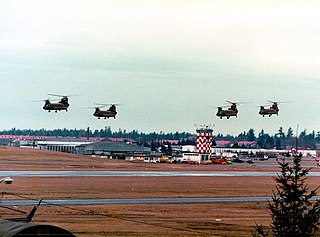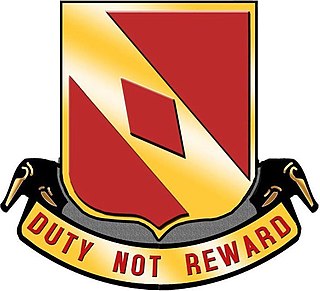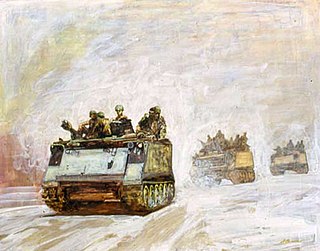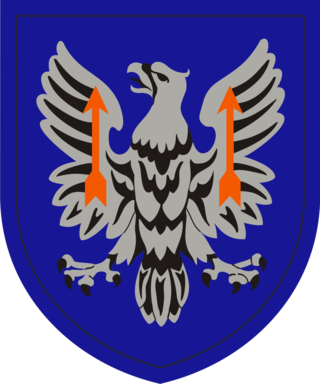
The 1st Cavalry Division is a combined arms division and is one of the most decorated combat divisions of the United States Army. It is based at Fort Cavazos, Texas. It was formed in 1921 and served during World War II, the Korean War, the Vietnam War, the Persian Gulf War, with the Stabilization Force in Bosnia-Herzegovina, in the Iraq War, in the War in Afghanistan as well as Operation Freedom's Sentinel and Operation Inherent Resolve. As of July 2023, the 1st Cavalry Division is subordinate to III Armored Corps and is commanded by Major General Kevin D. Admiral.

The 11th Armored Cavalry Regiment is a unit of the United States Army garrisoned at the Fort Irwin National Training Center in California. The regiment has served in the Philippine–American War, the Pancho Villa Expedition, World War II, the Vietnam War, Gulf War and Iraq War. The 11th ACR serves as the opposing force (OPFOR) for the Army and Marine task forces, and foreign military forces that train at Fort Irwin.

The 9th Infantry Division is an inactive infantry division of the United States Army. It was created as the 9th Division during World War I, but never deployed overseas. In later years it was an important unit of the U.S. Army during World War II and the Vietnam War. It was also activated as a peacetime readiness unit from 1947 to 1962 at Fort Dix, New Jersey, and Fort Carson, Colorado, and from 1972 to 1991 as an active-duty infantry division at Fort Lewis, Washington. The division was deactivated in December 1991.

Gray Army Airfield, also known as Gray AAF, is a military airfield located within Joint Base Lewis–McChord near Tacoma, in Pierce County, Washington, United States.

Aerial rocket artillery is a type of armed helicopter unit that was part of the artillery component of the United States Army's two airmobile divisions during the Vietnam War. Controlled by division artillery and not the aviation group, the 2nd Battalion, 20th Artillery, 1st Cavalry Division and the 4th Battalion, 77th Artillery, 101st Airborne Division, along with Battery F, 79th Artillery, 1st Cavalry Division, were the only ARA units fielded during that conflict. The ARA concept disappeared from Army aviation by the mid-1970s, replaced by more generic attack aviation units.

The Combat Aviation Brigade, 1st Infantry Division is the Army Aviation formation of the United States Army's 1st Infantry Division. The current commander of this brigade is Colonel Chad P. Corrigan.

Armoured cavalry are combat units using armoured fighting vehicles (AFVs) instead of horses. They began to replace horse cavalry in the heavy shock and the light reconnaissance, skirmishing and exploitation/pursuit roles in most armies commencing after the First World War.

The 17th Cavalry Regiment is a historical organization within the United States Army that began as a regiment of cavalry after the Pancho Villa Expedition. The unit was constituted on 1 July 1916 in the Regular Army as the 17th Cavalry at Fort Bliss, Texas and originally inactivated 26 September 1921 at the Presidio of Monterey, California. Formerly a part of the 1950s Combat Arms Regimental System, it was reorganized as a part of the U.S. Army Regimental System, an ongoing effort to maintain the lineage and history of the U.S. Army through its units. Today, the 17th Cavalry Regiment is found across the army within the combat aviation brigades, where the squadrons, now constituted as attack/recon helicopter squadrons, carry on the legacy of the 17th Cavalry Regiment.
The 229th Aviation Regiment is an aviation unit of the United States Army.

The 12th Combat Aviation Brigade is a Combat Aviation Brigade of the United States Army. It was first organized as the 12th Aviation Group at Fort Moore, Georgia, on 18 June 1965.

Camp Holloway is a former U.S. Army base near Pleiku in central Vietnam.
During the Vietnam War, one unit assigned to the 52nd Combat Aviation Battalion, 17th Combat Aviation Group, 1st Aviation Brigade was the 119th Assault Helicopter Company. The company operated throughout the Central Highlands of Vietnam during the war, from arrival in September 1962 until deactivation in November 1970. Originally designated the 81st Transportation Company, the company was reorganized in 1963 as the 119th Assault Helicopter Company (Airmobile), re-equipped with turbine-powered single-rotor UH-1A and B model Hueys. Also known as the 119th Aviation Company, the company's area of operations included the entire Central Highlands of Vietnam, plus large portions of Laos and Cambodia.

Simmons Army Airfield is a military use airport located in Cumberland County, North Carolina, United States. It is located on the southeast portion of Fort Liberty and supports the aviation needs of the XVIII Airborne Corps, the 82nd Airborne Division, Special Operations, U.S. Army Reserve and U.S. National Guard aviation units.

The 16th Combat Aviation Brigade is a Combat Aviation Brigade of the United States Army. It is subordinate to 7th Infantry Division and I Corps and based at Gray Army Airfield part of Joint Base Lewis-McChord (JBLM).

The 4th Aviation Regiment is an aviation regiment of the United States Army, tracing its history back to 1957.

The Combat Aviation Brigade, 101st Airborne Division is a Combat Aviation Brigade (CAB) of the United States Army. It was first organized in July 1968 as an aviation group and stands as the most decorated aviation unit in the United States Army. It was redesignated an aviation brigade in 1986. It has served in almost every single military operation since the Vietnam War. In support of the Global War on Terror, the CAB has distinguished itself as the military's premiere combat aviation unit during its two deployments to Iraq and five deployments to Afghanistan. The brigade has flown hundreds of thousands of hours during these combat tours, transporting millions of troops around the battlefield and providing close air support/aerial reconnaissance. The 101st broke its own record for longest air assault in history during the invasion of Iraq in 2003. Previously, the longest air assault was conducted in 1991 during Operation Desert Storm.

The 11th Expeditionary Combat Aviation Brigade is a Combat Aviation Brigade in the United States Army Reserve. The unit's lineage can be traced to the prior lineage and insignia of the 11th Aviation Group which was last headquartered in Illesheim, Germany in 2005. It is one of two aviation brigades of Army Reserve Aviation Command. The brigade consists of a headquarters company, two Black Hawk assault battalions, and one fixed wing battalion. The brigade was activated in its current formation on 16 September 2016.

The 52nd Aviation Regiment is an aviation regiment of the U.S. Army.
Larry Snook is a retired United States Army Colonel who served as Grimes County Judge from January 1, 1991, to December 31, 1994, and Grimes County Commissioner, Precinct 1 from January 1, 2000, to December 31, 2003.

The 1st Aviation Brigade is an aviation brigade of the United States Army, stationed at Fort Novosel in Alabama. In accordance with The Naming Commission recommendations Fort Rucker was renamed Fort Novosel in early 2023. It commands three distinctly different battalions—the 1st Battalion, 13th Aviation Regiment; the 1st Battalion, 145th Aviation Regiment; and the 2nd Battalion, 13th Aviation Regiment, the former Unmanned Aircraft Systems Training Battalion at Fort Huachuca, Arizona.




















